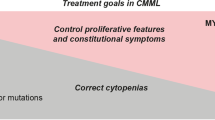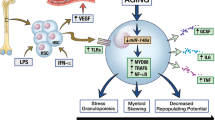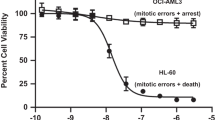Abstract
Despite extensive study in many malignancies, maintenance therapy has clinically benefited only two diseases: acute lymphocytic leukemia (ALL) and acute promyelocytic leukemia (APL). ALL maintenance therapy utilizes low-dose 6-mercaptopurine (6MP) and methotrexate (MTX), while maintenance in APL primarily consists of all-trans-retinoic acid (ATRA). 6MP and MTX as used in ALL are also now usually added to maintenance ATRA for APL, based on data suggesting an improved disease-free survival. Although the mechanism of action of MTX and 6MP as maintenance is unknown, low-dose cytotoxic agents are potent inducers of differentiation in vitro. Thus, we studied whether maintenance therapy in ALL, like ATRA in APL, may be inducing terminal differentiation of ALL progenitors. The APL cell line NB4, the ALL cell lines REH and RS4;11, and patients' ALL blasts were incubated with ATRA, 6MP, and MTX in vitro. All three drugs inhibited the clonogenic growth of the APL and ALL cell lines without inducing immediate apoptosis, but associated with induction of phenotypic differentiation. The three drugs similarly upregulated lymphoid antigen expression, while decreasing CD34 expression, on patients' ALL blasts. These data suggest that induction of leukemia progenitor differentiation plays an important role in the mechanism of action of maintenance therapy in ALL.
This is a preview of subscription content, access via your institution
Access options
Subscribe to this journal
Receive 12 print issues and online access
$259.00 per year
only $21.58 per issue
Buy this article
- Purchase on Springer Link
- Instant access to full article PDF
Prices may be subject to local taxes which are calculated during checkout




Similar content being viewed by others
References
Schrappe M, Reiter A, Ludwig W-D, Harbott J, Zimmermann M, Hiddemann W et al. Improved outcome in childhood acute lymphoblastic leukemia despite reduced use of anthracyclines and cranial radiotherapy: results of trial ALL-BFM 90. Blood 2000; 95: 3310–3322.
Boissel N, Auclerc M-F, Lhéritier V, Perel Y, Thomas X, Leblanc T et al. Should adolescents with acute lymphoblastic leukemia be treated as old children or young adults? Comparison of the French FRALLE-93 and LALA-94 trials. J Clin Oncol 2003; 21: 774–780.
Annino L, Vegna ML, Camera A, Specchia G, Visani G, Fioritoni G et al. Treatment of adult acute lymphoblastic leukemia (ALL): long-term follow-up of the GIMEMA ALL 0288 randomized study. Blood 2002; 99: 863–871.
Rowe JM, Buck G, Burnett AK, Chopra R, Wiernik PH, Richards SM et al. Induction therapy for adults with acute lymphoblastic leukemia: results of more than 1500 patients from the international ALL trial: MRC UKALL XII/ECOG E2993. Blood 2005; 106: 3760–3767.
Cassileth PA, Andersen JW, Bennett JM, Hoagland HC, Mazza JJ, O'Connell MC et al. Adult acute lymphocytic leukemia: the Eastern Cooperative Oncology Group experience. Leukemia 1992; 6: 178–181.
Cuttner J, Mick R, Budman DR, Mayer RJ, Lee EJ, Henderson ES et al. Phase III trial of brief intensive treatment of adult acute lymphocytic leukemia comparing daunorubicin and mitoxantrone: a CALGB Study. Leukemia 1991; 5: 425–431.
Childhood ALL Collaborative Group. Duration and intensity of maintenance chemotherapy in acute lymphoblastic leukaemia: overview of 42 trials involving 12 000 randomised children. Lancet 1996; 347: 1783–1788.
Young RC, Canellos GP, Chabner BA, Schein PS, DeVita VT . Maintenance chemotherapy for advanced Hodgkin's disease in remission. Lancet 1973; 1: 1339–1343.
Champlin R, Gale RP . Acute myelogenous leukemia: recent advances in therapy. Blood 1987; 69: 1551–1562.
San Miguel JF, Blade Creixenti J, Garcia-Sanz R . Treatment of multiple myeloma. Haematologica 1999; 84: 36–58.
DeVita Jr VT . Hodgkin's disease--clinical trials and travails. N Engl J Med 2003; 348: 2375–2376.
Tallman MS, Andersen JW, Schiffer CA, Appelbaum FR, Feusner JH, Ogden A et al. All-trans-retinoic acid in acute promyelocytic leukemia. N Engl J Med 1997; 337: 1021–1028.
Coffman FD, Studzinski GP . Differentiation-related mechanisms which suppress DNA replication. Exp Cell Res 1999; 248: 58–73.
Miller Jr WH, Waxman S . Differentiation induction as a treatment for hematologic malignancies. Oncogene 2002; 21: 3496–3506.
Matsui W, Smith BD, Vala M, Beal N, Huff CA, Diehl LF et al. Requirement for myeloid growth factors in the differentiation of acute promyelocytic leukaemia. Br J Haematol 2005; 128: 853–862.
Craig RW, Frankfurt OS, Sakagami H, Takeda K, Bloch A . Macromolecular and cell cycle effects of different classes of agents inducing the maturation of human myeloblastic leukemia (ML-1) cells. Cancer Res 1984; 44: 2421–2429.
Matsui WH, Gladstone DE, Vala MS, Barber JP, Brodsky RA, Smith BD et al. The role of growth factors in the activity of pharmacological differentiation agents. Cell Growth Differ 2002; 13: 275–283.
Tsiftsoglou AS, Pappas IS, Vizirianakis IS . Mechanisms involved in the induced differentiation of leukemia cells. Pharmacol Ther 2003; 100: 257–290.
Fenaux P, Chastang C, Chevret S, Sanz M, Dombret H, Archimbaud E et al. A randomized comparison of all transretinoic acid (ATRA) followed by chemotherapy and ATRA plus chemotherapy and the role of maintenance therapy in newly diagnosed acute promyelocytic leukemia. The European APL Group. Blood 1999; 94: 1192–1200.
Lanotte M, Martin-Thouvenin V, Najman S, Balerini P, Valensi F, Berger R . NB4, a maturation inducible cell line with t(15;17) marker isolated from a human acute promyelocytic leukemia (M3). Blood 1991; 77: 1080–1086.
Rosenfeld C, Goutner A, Venuat AM, Choquet C, Pico JL, Dore JF et al. An effect human leukaemic cell line: REH. Eur J Cancer 1977; 13: 377–379.
Stong RC, Korsmeyer SJ, Parkin JL, Arthur DC, Kersey JH . Human acute leukemia cell line with the t(4;11) chromosomal rearrangement exhibits B lineage and monocytic characteristics. Blood 1985; 65: 21–31.
Friend C, Scher W, Holland JG, Sato T . Hemoglobin synthesis in murine virus-induced leukemic cells in vitro: stimulation of erythroid differentiation by dimethyl sulfoxide. Proc Natl Acad Sci USA 1971; 68: 378–381.
Collins SJ, Ruscetti FW, Gallagher RE, Gallo RC . Terminal differentiation of human promyelocytic leukemia cells induced by dimethyl sulfoxide and other polar compounds. Proc Natl Acad Sci USA 1978; 75: 2458–2462.
Jones RJ, Barber JP, Vala MS, Collector MI, Kaufmann SH, Ludeman SM et al. Assessment of aldehyde dehydrogenase in viable cells. Blood 1995; 85: 2742–2746.
Balis FM, Holcenberg JS, Poplack DG, Ge J, Sather HN, Murphy RF et al. Pharmacokinetics and pharmacodynamics of oral methotrexate and mercaptopurine in children with lower risk acute lymphoblastic leukemia: a joint children's cancer group and pediatric oncology branch study. Blood 1998; 92: 3569–3577.
Lennard L, Lilleyman JS . Variable mercaptopurine metabolism and treatment outcome in childhood lymphoblastic leukemia. J Clin Oncol 1989; 7: 1816–1823.
Koren G, Ferrazini G, Sulh H, Langevin AM, Kapelushnik J, Klein J et al. Systemic exposure to mercaptopurine as a prognostic factor in acute lymphocytic leukemia in children. N Engl J Med 1990; 323: 17–21.
Pearson AD, Amineddine HA, Yule M, Mills S, Long DR, Craft AW et al. The influence of serum methotrexate concentrations and drug dosage on outcome in childhood acute lymphoblastic leukaemia. Br J Cancer 1991; 64: 169–173.
Matsui W, Huff CA, Vala M, Barber J, Smith BD, Jones RJ . Anti-tumour activity of interferon-alpha in multiple myeloma: role of interleukin 6 and tumor cell differentiation. Br J Haematol 2003; 121: 251–258.
George AA, Franklin J, Kerkof K, Shah AJ, Price M, Tsark E et al. Detection of leukemic cells in the CD34(+)CD38(-) bone marrow progenitor population in children with acute lymphoblastic leukemia. Blood 2001; 97: 3925–3930.
Hotfilder M, Rottgers S, Rosemann A, Jurgens H, Harbott J, Vormoor J . Immature CD34+CD19− progenitor/stem cells in TEL/AML1-positive acute lymphoblastic leukemia are genetically and functionally normal. Blood 2002; 100: 640–646.
Cox CV, Evely RS, Oakhill A, Pamphilon DH, Goulden NJ, Blair A . Characterization of acute lymphoblastic leukemia progenitor cells. Blood 2004; 104: 2919–2925.
Hotfilder M, Rottgers S, Rosemann A, Schrauder A, Schrappe M, Pieters R et al. Leukemic stem cells in childhood high-risk ALL/t(9;22) and t(4;11) are present in primitive lymphoid-restricted CD34+CD19− cells. Cancer Res 2005; 65: 1442–1449.
Castor A, Nilsson L, Astrand-Grundstrom I, Buitenhuis M, Ramirez C, Anderson K et al. Distinct patterns of hematopoietic stem cell involvement in acute lymphoblastic leukemia. Nat Med 2005; 11: 630–637.
Stoeckler JD, Stoeckler HA, Kouttab N, Maizel AL . 1alpha, 25-Dihydroxyvitamin D3 modulates CD38 expression on human lymphocytes. J Immunol 1996; 157: 4908–4917.
Sato S, Miller AS, Howard MC, Tedder TF . Regulation of B lymphocyte development and activation by the CD19/CD21/CD81/Leu 13 complex requires the cytoplasmic domain of CD19. J Immunol 1997; 159: 3278–3287.
Fujimoto M, Poe JC, Hasegawa M, Tedder TF . CD19 regulates intrinsic B lymphocyte signal transduction and activation through a novel mechanism of processive amplification. Immunol Res 2000; 22: 281–298.
Donis-Hernandez FR, Parkhouse RM, Santos-Argumedo L . Ontogeny, distribution and function of CD38-expressing B lymphocytes in mice. Eur J Immunol 2001; 31: 1261–1267.
Marty M, Ganem G, Fischer J, Flandrin G, Berger R, Schaison G et al. Acute promyelocytic leukemia: retrospective study of 119 patients treated with daunorubicin]. Nouv Rev Fr Hematol 1984; 26: 371–378.
Kantarjian HM, Keating MJ, Walters RS, Smith TL, McCredie KB, Freireich EJ . Role of maintenance chemotherapy in acute promyelocytic leukemia. Cancer 1987; 59: 1258–1263.
Song XD, Norman AW . Bryostatin-1 and 1alpha, 25-dihydroxyvitamin D3 synergistically stimulate the differentiation of NB4 acute promyelocytic leukemia cells. Leukemia 1999; 13: 275–281.
Muto A, Kizaki M, Yamato K, Kawai Y, Kamata-Matsushita M, Ueno H et al. 1,25-Dihydroxyvitamin D3 induces differentiation of a retinoic acid-resistant acute promyelocytic leukemia cell line (UF-1) associated with expression of p21(WAF1/CIP1) and p27(KIP1). Blood 1999; 93: 2225–2233.
Bhatia M, Kirkland JB, Meckling-Gill KA . M-CSF and 1, 25 dihydroxy vitamin D3 synergize with 12-O-tetradecanoylphorbol-13-acetate to induce macrophage differentiation in acute promyelocytic leukemia NB4 cells. Leukemia 1994; 8: 1744–1749.
Miller Jr WH, Schipper HM, Lee JS, Singer J, Waxman S . Mechanisms of action of arsenic trioxide. Cancer Res 2002; 62: 3893–3903.
Niitsu N, Higashihara M, Honma Y . The catalytic DNA topoisomerase II inhibitor ICRF-193 and all-trans retinoic acid cooperatively induce granulocytic differentiation of acute promyelocytic leukemia cells: candidate drugs for chemo-differentiation therapy against acute promyelocytic leukemia. Exp Hematol 2002; 30: 1273–1282.
Defacque H, Dornand J, Commes T, Cabane S, Sevilla C, Marti J . Different combinations of retinoids and vitamin D3 analogs efficiently promote growth inhibition and differentiation of myelomonocytic leukemia cell lines. J Pharmacol Exp Ther 1994; 271: 193–199.
Gozzini A, Rovida E, Dello Sbarba P, Galimberti S, Santini V . Butyrates, as a single drug, induce histone acetylation and granulocytic maturation: possible selectivity on core binding factor-acute myeloid leukemia blasts. Cancer Res 2003; 63: 8955–8961.
Pinto A, Attadia V, Fusco A, Ferrara F, Spada OA, Di Fiore PP . 5-Aza-2′-deoxycytidine induces terminal differentiation of leukemic blasts from patients with acute myeloid leukemias. Blood 1984; 64: 922–929.
Gore SD, Baylin S, Sugar E, Carraway H, Miller CB, Carducci M et al. Combined DNA methyltransferase and histone deacetylase inhibition in the treatment of myeloid neoplasms. Cancer Res 2006; 66: 6361–6369.
Copelan EA, McGuire EA . The biology and treatment of acute lymphoblastic leukemia in adults. Blood 1995; 85: 1151–1168.
Acknowledgements
Supported in part by National Institutes of Health grants P01 CA15396 and P01 CA70970. TLL is a recipient of an ASCO Foundation YIA.
Author information
Authors and Affiliations
Corresponding author
Rights and permissions
About this article
Cite this article
Lin, T., Vala, M., Barber, J. et al. Induction of acute lymphocytic leukemia differentiation by maintenance therapy. Leukemia 21, 1915–1920 (2007). https://doi.org/10.1038/sj.leu.2404823
Received:
Revised:
Accepted:
Published:
Issue Date:
DOI: https://doi.org/10.1038/sj.leu.2404823
Keywords
This article is cited by
-
Maintenance Treatment in Acute Lymphoblastic Leukemia: A Clinical Primer
Indian Journal of Pediatrics (2024)
-
Combination of chemotherapy and all-trans retinoic acid for the treatment KMT2A-rearranged infant acute lymphoblastic leukemia. Results of the MLL-Baby trial
Leukemia (2023)
-
A small molecular compound CC1007 induces cross-lineage differentiation by inhibiting HDAC7 expression and HDAC7/MEF2C interaction in BCR-ABL1− pre-B-ALL
Cell Death & Disease (2020)
-
A reliable Raman-spectroscopy-based approach for diagnosis, classification and follow-up of B-cell acute lymphoblastic leukemia
Scientific Reports (2016)
-
Differentiation-Inducing Activity of Hydroxycamptothecin on Cancer Stem-Like Cells Derived from Hepatocellular Carcinoma
Digestive Diseases and Sciences (2011)



